
The Church of the Gesù is the mother church of the Society of Jesus (Jesuits), a Catholic religious order. Officially named Chiesa del Santissimo Nome di Gesù all'Argentina, its façade is "the first truly baroque façade", introducing the baroque style into architecture. The church served as a model for innumerable Jesuit churches all over the world, especially in the Americas. Its paintings in the nave, crossing, and side chapels became models for Jesuit churches throughout Italy and Europe, as well as those of other orders. The Church of the Gesù is located in the Piazza del Gesù in Rome.
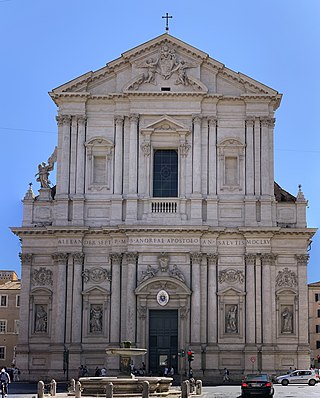
Sant'Andrea della Valle is a minor basilica in the rione of Sant'Eustachio of the city of Rome, Italy. The basilica is the general seat for the religious order of the Theatines. It is located at Piazza Vidoni, at the intersection of Corso Vittorio Emanuele and Corso Rinascimento.

The Basilica of Saint Augustine in Camp Martius, commonly known as Basilica of Saint Augustine is a Roman Catholic minor basilica in Rome. The titular church is dedicated to Saint Augustine of Hippo and serves as the motherhouse of the Augustinian Order.

The Church of St. Louis of the French is a Catholic church near Piazza Navona in Rome. The church is dedicated to the patron saints of France: Virgin Mary, Dionysius the Areopagite and King Louis IX of France.

San Francesco a Ripa is a church in Rome, Italy. It is dedicated to Francis of Assisi who once stayed at the adjacent convent. The term Ripa refers to the nearby riverbank of the Tiber.

Santa Cecilia in Trastevere is a 5th-century church in Rome, Italy, in the Trastevere rione, devoted to the Roman martyr Saint Cecilia.

The Minor Basilica of St. Lawrence in Damaso or simply San Lorenzo in Damaso is a parish and titular church in central Rome, Italy that is dedicated to St. Lawrence, deacon and martyr. It is incorporated into the Palazzo della Cancelleria, which enjoys the extraterritoriality of the Holy See.
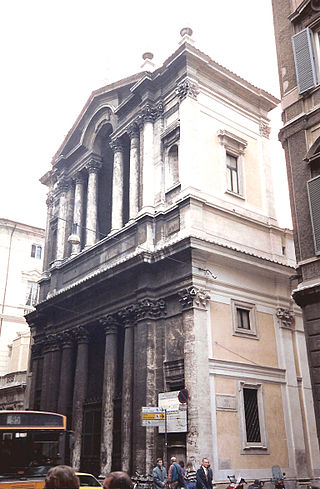
Santa Maria in Via Lata is a church on the Via del Corso, in Rome, Italy. It stands diagonal from the church of San Marcello al Corso.

Santa Maria in Campitelli or Santa Maria in Portico is a church dedicated to the Virgin Mary on the narrow Piazza di Campitelli in Rione Sant'Angelo, Rome, Italy. The church is served by the Clerics Regular of the Mother of God.
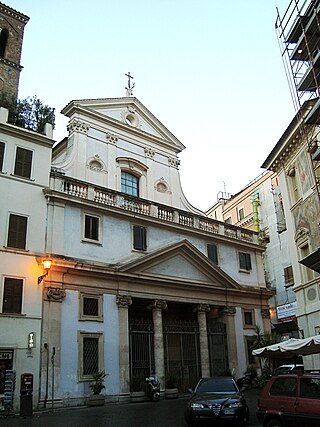
Sant'Eustachio is a Roman Catholic titular church and minor basilica in Rome, named for the martyr Saint Eustace. It is located on Via di Sant'Eustachio in the rione Sant'Eustachio, a block west of the Pantheon and via della Rotonda, and a block east of Sant'Ivo alla Sapienza and the Via della Dogana Vecchia.

The Basilica della Santissima Annunziata del Vastato is the Catholic cathedral of Genoa, northern Italy; its decoration employed the major baroque studios and artists in Genoa in the 17th century.
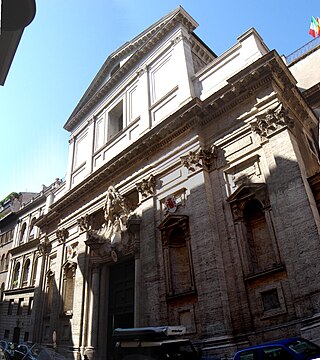
The Spanish National Church of Santiago and Montserrat, known as Church of Holy Mary in Monserrat of the Spaniards is a Roman Catholic titulus church and National Church in Rome of Spain, dedicated to the Virgin of Montserrat. It is located in the Rione Regola, at the intersection of alleyway of Via della Barchetta and the narrow Via di Monserrato, with the facade on the latter street, about three blocks northwest of the Palazzo Farnese.

Santa Caterina dei Funari is a church in Rome in Italy, in the rione of Sant'Angelo. The church is mainly known for its façade and its interior with frescoes and paintings.

La Chiesa di San Rocco is a Roman Catholic building that is part of the Parish of Saint Giacomo. The original conjoined building dates from 1499 and is located at 1 Largo San Rocco, Rome.

The Church of Saint Lucy in Selci is an ancient Roman Catholic church, located in Rome, dedicated to Saint Lucy, a 4th-century virgin and martyr.

The Chiesa della Santissima Trinità dei Pellegrini is a Roman Catholic church located on Via dei Pettinari #36 In the rione of Regola of central Rome, Italy. It stands a block away from the Palazzo Spada on Via Capo di Ferro, while a few blocks away on the Via dei Pettinari stands the Ponte Sisto.
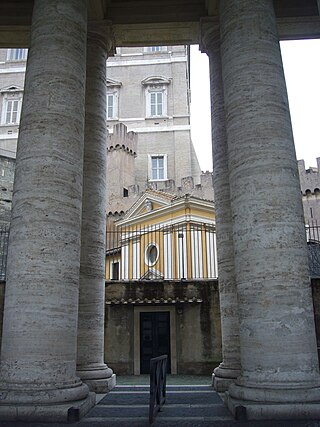
The Church of Saints Martin and Sebastian of the Swiss is a Roman Catholic oratory in Vatican City. The church was built by Pope Pius V in 1568 to serve as a private chapel for the Pontifical Swiss Guards, whose barracks are located next to Porta San Pellegrino, close to the Apostolic Palace. It is considered the national church of Switzerland in Rome.
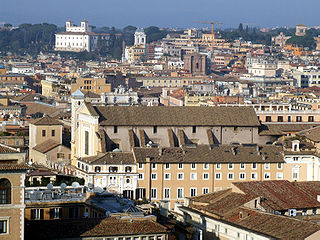
Santi Dodici Apostoli, commonly known simply as Santi Apostoli, is a 6th-century Roman Catholic parish and titular church and minor basilica in Rome, Italy, dedicated originally to St. James and St. Philip, whose remains are kept here, and later to all Apostles. Today, the basilica is under the care of the Conventual Franciscans, whose headquarters in Rome is in the adjacent building. It is the Station church for Friday, the first week of Lent.
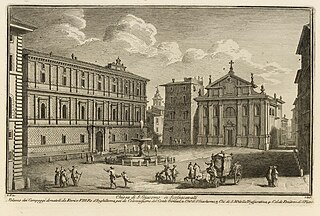
San Giacomo Scossacavalli was a church in Rome important for historical and artistic reasons. The church, facing the Piazza Scossacavalli, was built during the early Middle Ages and since the early 16th century hosted a confraternity which commissioned Renaissance architect Antonio da Sangallo the Younger to build a new shrine. This was richly decorated with frescoes, painted by mannerist artist Giovanni Battista Ricci and his students. The church was demolished in 1937, when Via della Conciliazione was built and the piazza and central part of the Borgo rione were demolished. Many decorative elements still exist, since they were preserved from demolition.

San Michele Arcangelo ai Corridori di Borgo was a church in Rome dedicated to St. Michael, the Archangel, important for historical and artistic reasons.























